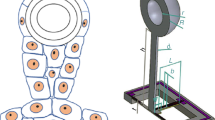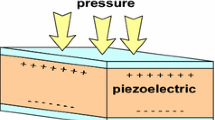Abstract
In this paper, micro-electromechanical systems (MEMS) technology and the bionic principle are used to develop a low-frequency high-sensitivity three-dimensional omni-vector hydrophone that can obtain vector information of an underwater sound field by imitating the auditory principle of a fish’s lateral line organ. The key features are smaller size, better consistency, better low-frequency characteristic, higher sensitivity, and rigid mounting, which thus allow a spatial acoustic source to be detected directionally by a single hydrophone. The bionic MEMS microstructure was designed and fabricated and consists of two components: the vertical detection unit including a four-beam-cilium structure and a level detection unit including a double T-shaped beam structure. On the basis of theoretical analysis, the structure size and layout location of the piezoresistors are determined by simulation analysis and the double cilia type microstructure is fabricated integrally by MEMS manufacturing technology; after which the acoustic package of the microstructure is complete and the prototype is produced. Finally, this paper presents the experimental characterization of the microdevice, validating the concept and the analytical models used. The test results show that the three-dimensional vector hydrophone has a flat frequency response curve, exhibits a sensitivity of −185 dB (X, Y) and −181 dB (Z) (1 kHz, 0 dB reference 1 V/uPa) and shows a good directivity pattern in the form of an “8” shaped. More importantly, the depth of the concave point reaches 47.7 dB, and the asymmetry is only 0.5 dB, indicating that the three-dimensional vector hydrophone has great advantages in spatial orientation, which is suitable for applications in sonar systems.



















Similar content being viewed by others
References
Barth FG (2002) Spider senses-technical perfection and biology. Zoology 105:271–285. doi:10.1078/0944-2006-00082
Bauer BB (1966) Laboratory calibration for gradient hydrophones. J Acoustic Soc Am 39:585–586. doi:10.1121/1.1909934
Beccai L, Roccella S, Arena A et al (2005) Design and fabrication of a hybrid silicon three-axial force sensor for biomechanical application. Sens Actuat A 120:370–382. doi:10.1016/j.sna.2005.01.007
Chen NN, Chen J, Engel J et al (2006) Development and characterization of high sensitivity bioinspired artificial haircell sensor. In: The 12th solid state sensors, actuator, and microsystems workshop, Hilton Head Island, SC, USA, June 4–8
Chen NN, Tucker C, Engel JM et al (2007) Design and characterization of artificial haircell sensor for flow sensing with ultrahigh velocity and angular sensitivity. J Microelectromech Syst 16:999–1014. doi:10.1109/JMEMS.2007.902436
Dijkgraaf S (1963) The functioning and significance of the lateral-line organs. Biol Rev 38:51–105. doi:10.1111/j.1469-185X.1963.tb00654.x
Disler NN, Smirnov SA (1977) Sensory organs of lateral-line canal system in two periods and their importance in behavior. J Fish Res Board Can 34:1492–1505. doi:10.1139/f77-214
Fan ZF, Chen J, Zou J et al (2002) Design and fabrication of artificial lateral-line flow sensors. J Micromech Microeng 12:655–661. doi:10.1088/0960-1317/12/5/322
Fei T (2005) Vector hydrophone Calibration Equipment. Acoust Technology, Supplement, pp 673–677
Gordienko VA, Gordienko EL, Dryndin AV, Likhachev SM (1994) Absolute pressure calibration of acoustic receivers in a vibrating column of liquid. Acoust Phys 40:219–222
Hong LJ, Yang DS, Shi SG (2011) Study on a medium three dimensional co-oscillating vector hydrophone. J Vib Shock 30:79–84
Izadi N, de Boer MJ, Berenschot JW et al (2009) Fabrication of dense flow sensor arrays on flexible membranes. Transducers Conference, Denver, CO, USA, June 21–25, pp 1075–1078. doi:10.1109/SENSOR.2009.5285945
Jande SS (1966) Fine structure of lateral-line organs of frog tadpoles. J Ultrast Res 15:496–509. doi:10.1016/S0022-5320(66)80122-3
Krijnen GJM, Dijkstra M, van Baar JJ et al (2006) MEMS based hair flow-sensors as model systems for acoustic perception studies. Nanotechnology 17:S84–S89. doi:10.1088/0957-4484/17/4/013
Metcalfe WK, Kimmel CB, Schabtach E (1985) Anatomy of the posterior lateral line system in young larvae of the zebrafish. J Comp Neurol 233:377–389. doi:10.1002/cne.902330307
Miles RN, Cui W, Su Q et al (2006a) Development of novel biologically inspired directional mocrophones. J Acoust Soc Am 120:3158–3166. doi:10.1121/1.4787858
Miles RN, Su Q, Cui W et al (2006b) A low-noise differential microphone inspired by the ears of the parasitoid fly Ormia ochracea. J Acoust Soc Am 125:2013–2026. doi:10.1121/1.3082118
Morse PM, Ingard KU (1968) Theoretical acoustics. McGraw-Hill Inc, New York
Muller HM (1996) Indications for feature detection with the lateral line organ in fish. Comp Biochem Phys A 114:257–263. doi:10.1016/0300-9629(95)02140-X
Nehorai A, Paldi E (1994) Acoustic vector-sensor array processing. IEEE Trans Signal Process 42:2481–2491. doi:10.1109/78.317869
Palanisamy P, Kalyanasundaram N, Swetha PM (2012) Two-dimensional DOA estimation of coherent signals using acoustic vector sensor array. Sig Process 92:19–28. doi:10.1016/j.sigpro.2011.05.021
Pierce AD (1981) Acoustics—an introduction to its physical principles and applications. McGraw-Hill Inc., New York
Rockstad HK, Kenny TW, Kenny PJ et al (1996) A microfabricated electron-tunneling accelerometer as a directional underwater acoustic sensor. Acoustic particle velocity sensors: design, performance, and applications. Am Inst Phys Conf Proc 368:57–68. doi:10.1063/1.50357
Sand O (1981) The lateral line and sound reception. In: Tavolga WN, Popper AN, Fay RR (eds) Hearing and sound communication in fishes. Springer, New York, pp 459–480. doi:10.1007/978-1-4615-7186_23
Schloss F, Strasberg M (1962) Hydrophone calibration in a vibrating column of liquid. J. Acoustic. Soc. Am 34:958–960. doi:10.1121/1.1918228
Shi SG, Yang DS, Hong LJ (2009) Research on sound wave receiving theory of co-oscillating sphere type vector hydrophone. Acta Austica 34:30–38
Shipps JC, Deng K (2003) A miniature vector sensor for line array applications. Proc IEEE Oceans Conf 4:2367–2370. doi:10.1109/OCEANS.2003.178284
Wirsching PH, Thomas LP, Ortiz K (2006) Random vibrations. Dover Publications, New York
Xue CY, Chen S, Zhang WD et al (2007) Design, fabrication, and preliminary characterization of a novel MEMS bionic vector hydrophone. Microelectron J 38:1021–1026. doi:10.1016/j.mejo.2007.09.008
Yang YC, Chen NN, Tucker C et al (2007) From artificial hair cell sensor to artificial lateral line system: development and application. In: Proceedings of the IEEE international conference on micro electro mechanical systems (MEMS), pp 577–580. doi:10.1109/MEMSYS.2007.4432986
Zhang WD, Guan LG, Zhang GJ et al (2009) Research of DOA estimation based on single MEMS vector hydrophone. Sensors 9:6823–6834. doi:10.3390/s90906823
Zou J, Chen J, Liu C et al (2001) Plastic deformation magnetic assembly (PDMA) of out-of-plane microstructures: technology and application. J Microelectromech Syst 10:302–309. doi:10.1109/84.925791
Acknowledgments
This work was financially supported by the grants from the National High Technology Research and Development Program of China (863 program) (Grant No. 2011AA040404), the International Cooperative Project (Grant No. 2010DFB10480) and the National Natural Science Foundation of China (Grant No. 51205374).
Author information
Authors and Affiliations
Corresponding authors
Rights and permissions
About this article
Cite this article
Zhang, G.J., Liu, L.X., Zhang, W.D. et al. Design of a monolithic integrated three-dimensional MEMS bionic vector hydrophone. Microsyst Technol 21, 1697–1708 (2015). https://doi.org/10.1007/s00542-014-2262-0
Received:
Accepted:
Published:
Issue Date:
DOI: https://doi.org/10.1007/s00542-014-2262-0




